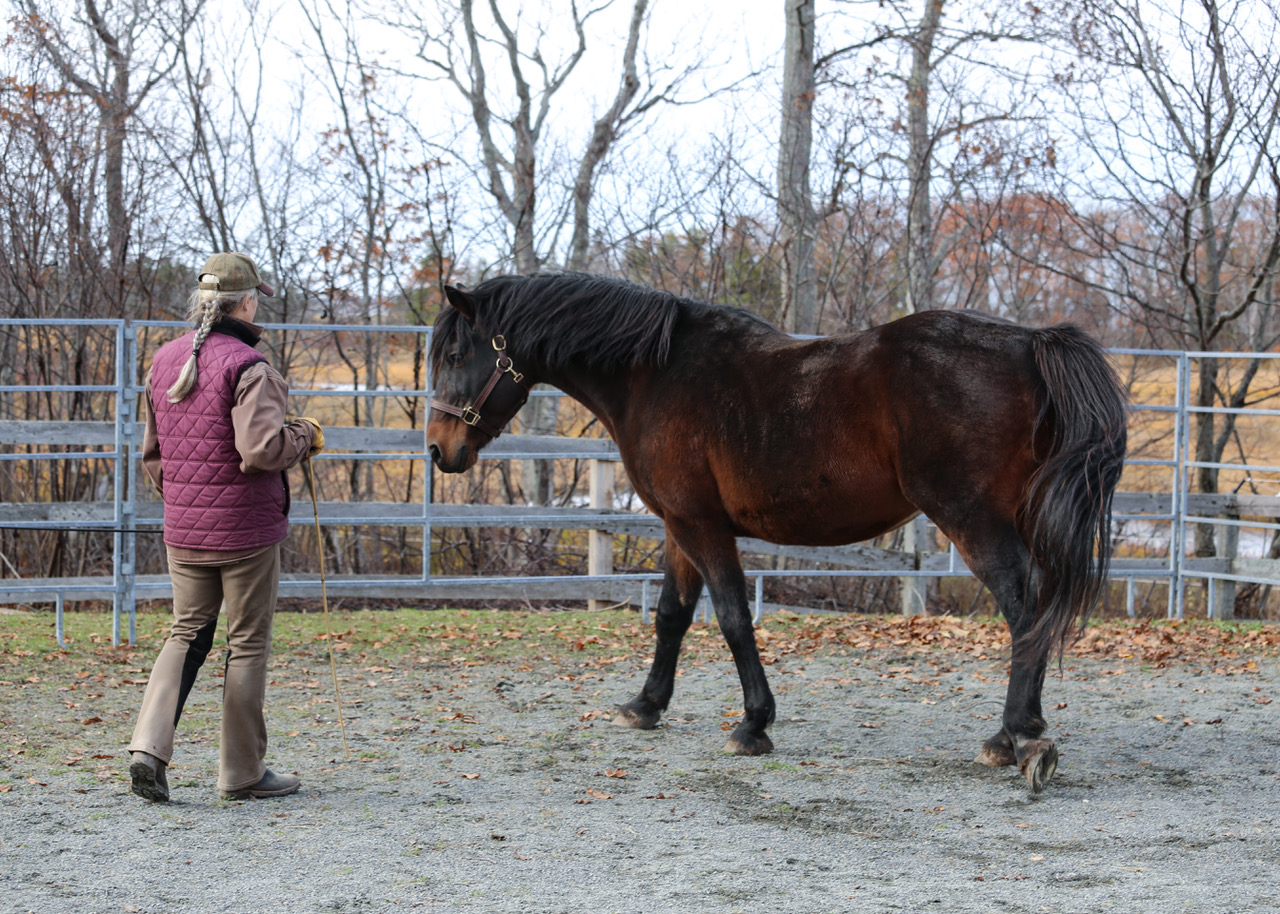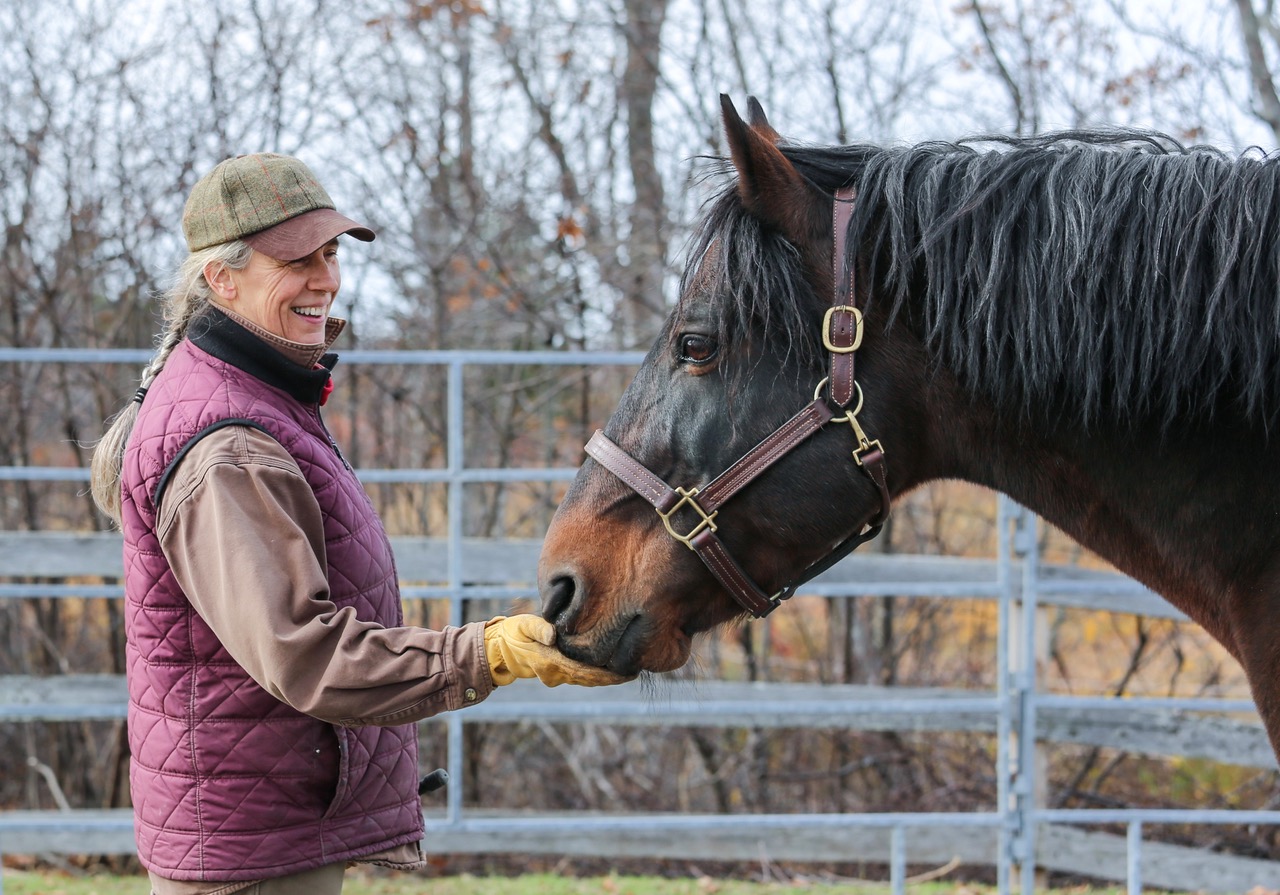One fall day a few years ago, Image and I had a beautiful conversation about being connected to each other. My aspiration was – and remains – that he and I be equal partners in the dance of connection.
Image and his family entered the area where my training pen is situated. It is about 100 feet square with the 40 feet square training pen within it. It was a nice day. I took the mounting block inside the pen and left the gate open. The horses were nibbling bits of grass and exploring outside the pen. I came and went a couple of times when my assistant Evangelinia needed my input.
At one point Evangelinia and I were standing near the training pen gate when Image came over to say hello. That was nice, he doesn’t often approach for a greeting unless there is food. We said hello and I scratched his face, which he loves. I gestured for Evangelinia to walk into the pen with me to see if Image would follow us. And he did! She went back to her work and I sat down on the mounting block. Image sniffed around, delicately nibbled old dead grass shoots, and talked to his mares over the fence. The gate was open. He had choices.
Image approached to greet me as I sat on the mounting block. Then, I went to get a halter and lead rope from the barn. I chose a regular flat halter instead of something that might have implied “training” like a rope halter or cavesson. I returned to the pen where Image remained, and sat down again. He didn’t approach, but he also didn’t leave. The gate was still open.
Next, I walked toward him with the intention of putting the halter on. My intention was that simple: Can we be connected, please? I didn’t get ahead of myself thinking about all the cool things “I” wanted to do with him. No. Very simple. One thing at a time. Can we be connected? Like many horses he is a little bit sceptical of connection, but he is also a gentleman.
This is the point in the story that relates to the title. As I walked toward Image, I stopped the instant he responded in a way I could see. I was about four steps away from him, maybe eight or ten feet. Now we were in the conversation zone.
Horsemanship people talk about pressure and release as a training technique. But often they describe what strikes me as an exaggerated version that may include escalation of pressure before a release. Others don’t like that approach, and exaggerate in the other direction by attempting to avoid any pressure at all. I land in the middle. There is no life without pressure! Gravity is pressure. The blanket on my legs as I write is pressure. A hug is pressure. I feel a certain kind of pressure when someone walks into the room. Pressure is not good or bad, it is simply part of the physics of our planet and our bodies.
The instant I took steps toward Image with the halter and lead rope in my hand, he felt pressure. As best I could perceive his response, I stopped as soon as he acknowledged that pressure. That was the first release. Stop, and ever so slightly rock back while keeping my body and intention soft – pressure off. Then, rock toward him again in the beginning of a step – pressure on. He turns his nose away ever so slightly, I rock back – pressure off. I pause and take a slow deep breath. I start toward him again – pressure on. This time he flicks an ear toward me so I rock back again – pressure off.
This is the point I am contemplating. I gave Image the same release when I saw a “No” from him as when I saw a “Yes”. Tipping his nose away is a No sign. Nose or eye or ear toward me is a gesture of Yes. I am curious about that. In one instance, I communicate that I get the message that he is not ready for me to approach. In the next instance, I say thank you for staying open to my request. The same release communicating two different things. How interesting!
I was looking for him to stay open to me as I approached his face. There was more rocking as I communicated both, “I hear ya,” and “Thank you.” And there were a few pauses just for the sake of pause and breathe.
Once I got to his face, I gave him a scratch. He was positioned with his left side next to the fence, making it awkward for me to put the halter on. I tried anyway, but he tipped his nose away and moved off a few steps. He didn’t leave. However, he had turned and I now had open access to the easier side for haltering. This time he let me approach and did not turn away. I put the halter on and thanked him with a pause, rock back, and breathe.
The connection of a lead rope looped between my hand and the halter on his face is pressure. He can feel it and I can feel it. We tend to think of contact as beginning when the rope or rein is straight rather than looped. To the horse, contact occurs the moment they are attached to a human – or even before.
Image could feel and see my invitation to walk with me. He came along nicely. I made a few tight turns, both to keep him engaged with me and to test our connection. He followed beautifully. If the rope became straight I did not increase the pressure in response. Rather, I softened and invited using the same rocking of my body and energy as before. Or, I simply followed him within our small pen. Did he lead me to the mounting block?! Hard to say, but there we were so I stepped up onto it. From there, I scratched his head again. He didn’t leave. I came down off the mounting block, removed the halter, and thanked him.
All this took maybe ten minutes. It stayed soft throughout. Image could have left at any time through the open gate. This was my invitation to dance. My intention is to take this softness and connection all the way to riding. I aspire to practice advanced dressage movements with him, many of which he knows from previous training. I visualize those movements arising from the release, arising from the softness. Joyfully offered from “Yes,” “I hear you,” and “Thank you.” It’s all about the release!
Photo by Sarah Baker Forward 2021.



